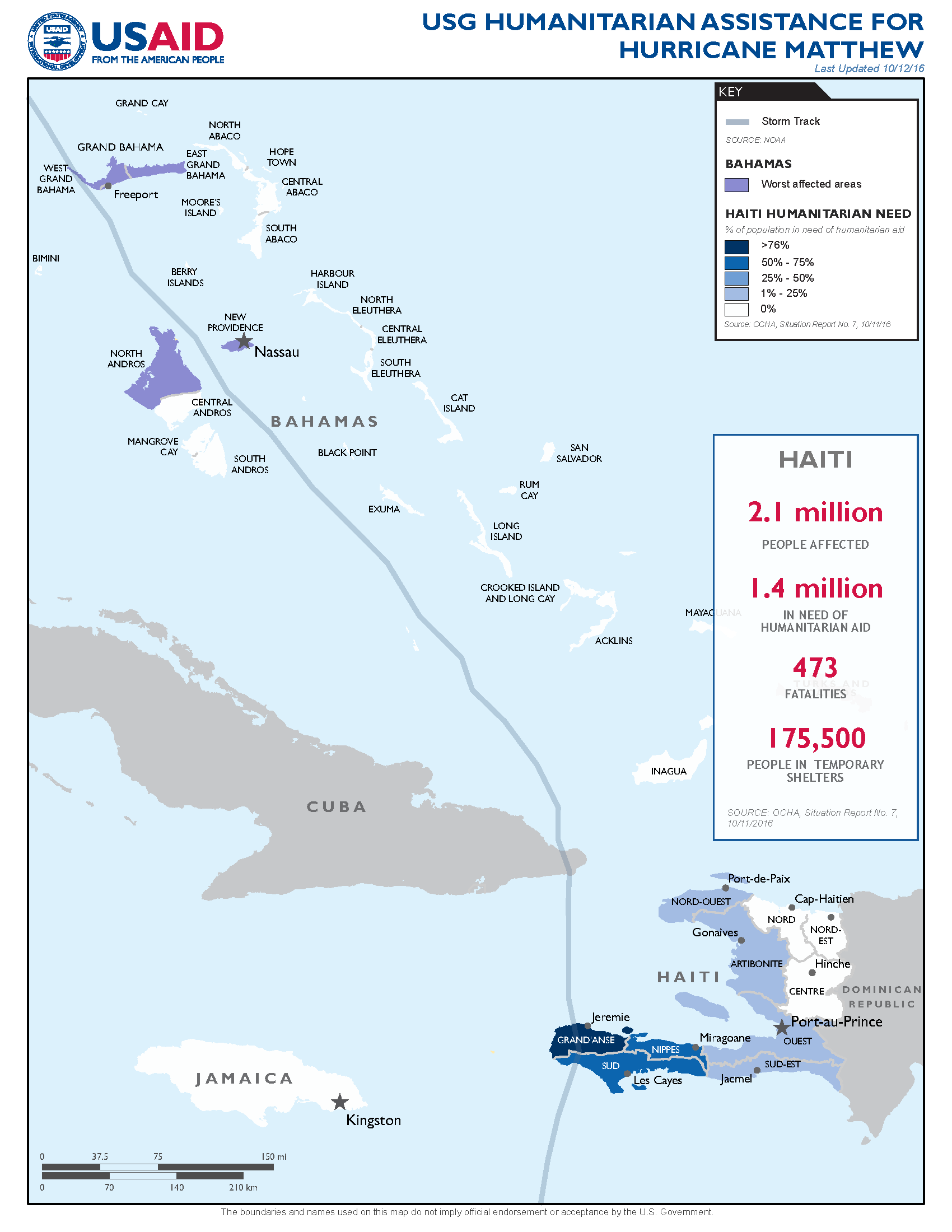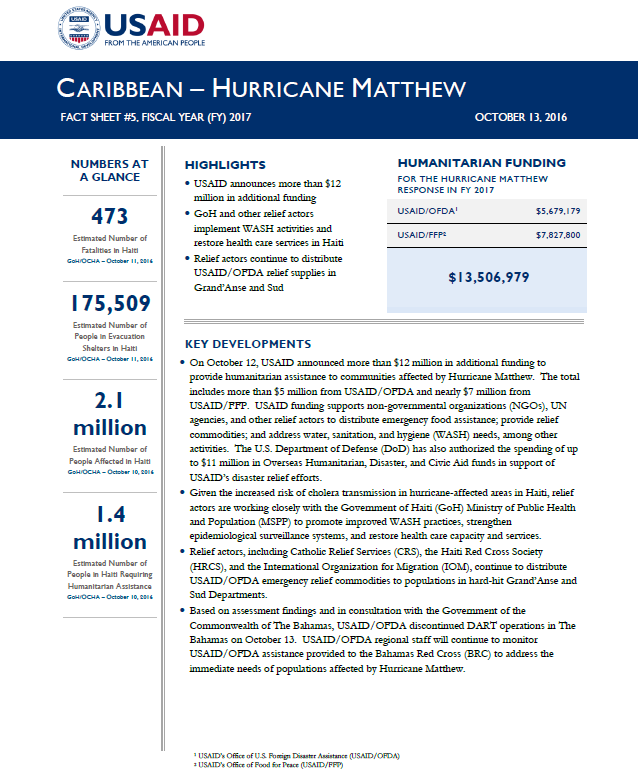Speeches Shim
October 13, 2016
Highlights
USAID announces more than $12 million in additional funding
Government of Haiti (GoH) and other relief actors implement WASH activities and restore health care services in Haiti
Relief actors continue to distribute USAID/OFDA relief supplies in Grand’Anse and Sud
Key Developments
Numbers At A Glance
473
175,509
2.1 million
1.4 million
Humanitarian Funding
For the Hurricane Matthew Response
in FY 2017
| USAID/OFDA | $5,679,179 |
| USAID/FFP | $7,827,800 |
| TOTAL | $13,506,979 |
On October 13, USAID announced more than $12 million in additional funding to provide humanitarian assistance to communities affected by Hurricane Matthew. The total includes more than $5 million from USAID/OFDA and nearly $7 million from USAID/FFP. USAID funding supports non-governmental organizations (NGOs), UN agencies, and other relief actors to distribute emergency food assistance; provide relief commodities; and address water, sanitation, and hygiene (WASH) needs, among other activities. The U.S. Department of Defense (DoD) has also authorized the spending of up to $11 million in Overseas Humanitarian, Disaster, and Civic Aid funds in support of USAID’s disaster relief efforts.
Given the increased risk of cholera transmission in hurricane-affected areas in Haiti, relief actors are working closely with the Government of Haiti (GoH) Ministry of Public Health and Population (MSPP) to promote improved WASH practices, strengthen epidemiological surveillance systems, and restore health care capacity and services.
Relief actors, including Catholic Relief Services (CRS), the Haiti Red Cross Society (HRCS), and the International Organization for Migration (IOM), continue to distribute USAID/OFDA emergency relief commodities to populations in hard-hit Grand’Anse and Sud Departments.
Based on assessment findings and in consultation with the Government of the Commonwealth of The Bahamas, USAID/OFDA discontinued DART operations in The Bahamas on October 13. USAID/OFDA regional staff will continue to monitor USAID/OFDA assistance provided to the Bahamas Red Cross (BRC) to address the immediate needs of populations affected by Hurricane Matthew.
LOGISTICS SUPPORT AND RELIEF COMMODITIES
The GoH Ministry of Interior and Territorial Communities reports that Hurricane Matthew damaged an estimated 60 percent of roads in Haiti’s southern peninsula, which comprises Grand’Anse, Nippes, Sud, and Sud-est departments. Although the GoH Directorate of Civil Protection (DPC) and response organizations have successfully restored road access along some routes, including corridors between Sud’s Les Cayes and Port Salut communes and Grand’Anse’s Dame-Marie and Jeremie communes, flooding, landslides, and debris continue to constrain commercial and humanitarian access in other areas, particularly along coastal roads. For example, road conditions between Dame-Marie and Anse d’Hainault communes in Grand’Anse remains challenging, and road access between Sud’s Tiburon and Port Salut communes is limited, according to a USAID/OFDA consultant working with the DPC.
USAID/OFDA recently provided more than $2 million to support the UN World Food Program (WFP) special operation. The project will strengthen the relief agency’s logistics and telecommunications capabilities to enhance coordination of land, sea, and air humanitarian operations in Haiti.
As of October 12, CRS had distributed emergency food assistance and emergency relief items—including blankets, cooking materials, hygiene kits, plastic sheeting—to approximately 4,000 people across Jeremie, and Sud’s Les Cayes, Port Salut, Roche-a-Bateau, and Saint Jean du Sud communes, with USAID/OFDA support. USAID/OFDA partner IOM also continues to distribute relief supplies to hurricane-affected populations in Grand’Anse.
HRCS, in conjunction with USAID/OFDA partner the American Red Cross (AmCross) had delivered hygiene and kitchen sets to more than 360 households in Sud as of October 12. AmCross and HRCS have also delivered blankets and hygiene kits to more than 250 households, as well as cholera kits to three hospitals, in Nord-Ouest Department, with further distributions of relief commodities planned in the coming days.
On October 13, DART-coordinated DoD helicopter relief flights delivered cholera treatment supplies to Les Cayes, as well as beans, cooking oil, and rice to Dame-Marie, where local NGO Mission of Hope Haiti will facilitate distributions to affected populations. DoD helicopters also delivered rice to Abricot commune in Grand’Anse for distribution by CRS and to Les Anglais for distribution by Mission of Hope Haiti.
HEALTH AND WASH
The GoH Directorate of Civil Protection (DPC) reports that at least 11 of 33 hospitals in the hard-hit departments of Grand’Anse, Nippes, and Sud sustained damage following the hurricane. The storm also damaged most of Grand’Anse’s cholera treatment centers and affected 34 of 212 centers for treatment of acute diarrhea countrywide, according to the DPC and the Pan American Health Organization (PAHO). Given the increased risk of cholera transmission in hurricane-affected areas in Haiti, relief actors are working closely with the MSPP to promote improved WASH practices, strengthen epidemiological surveillance systems, and restore health care capacity and services.
In coordination with the UN World Health Organization (WHO) and the MSPP, PAHO has deployed staff and established field operations in Jeremie commune, Grand’Anse, and Les Cayes commune, Sud. PAHO and WHO are also supplying cholera kits—comprising of catheters, oral rehydration solutions, and water chlorination treatments—to ensure capacity to treat patients with acute diarrhea and cholera. Additionally, WHO reports plans to provide 1 million doses of the cholera vaccination.
Médecins Sans Frontières is working to restore isolation and treatment capacity in Sud’s Port-a-Piment commune through the construction of a 150-bed cholera treatment center. The NGO reports treating nearly 90 cholera patients in the commune as of October 11.
The U.S. Centers for Disease Control and Prevention (CDC) is conducting phone interviews with community stakeholders in Grand’Anse’s Anse d’Hainault, Chambellan, Dame Marie, and Moron communes, where stakeholders report significant food, health, shelter, and WASH needs. In Chambellan, community stakeholders report deterioration in hygiene and sanitation conditions due to damaged latrines. Stakeholders in Moron report that residents are consuming water from unprotected sources, including a river, and where open defecation is prevalent. Stakeholders in all four communes report limited access to household chlorination supplies. CDC is also working with health partners to conduct case investigations and surveillance activities. CDC is working with MSPP, PAHO, and WHO to assess the feasibility and opportunity of mass Oral Cholera Vaccination campaigns in affected areas. CDC notes that, for optimal results, the vaccination campaign should be integrated into a comprehensive cholera response.
USAID/OFDA is working with CDC and other response partners to help prevent cholera transmission in hurricane-affected areas. USAID/OFDA airlifted water purification tablets to Haiti to provide safe drinking water for approximately 475,000 people. USAID/OFDA is also procuring 38 metric tons (MT) of chlorine to help local water authorities chlorinate piped water systems throughout the country, with immediate focus on high-risk areas.
Although preliminary findings have identified significant WASH needs in hurricane-affected communities, comprehensive information regarding the status of water infrastructure remains unavailable for many locations, particularly in remote areas of Grand’Anse and Sud, according to relief actors. The global WASH Cluster—the coordinating body for humanitarian WASH activities, comprised of UN agencies, NGOs, and other stakeholders—recently deployed five staff to Jeremie and Les Cayes to coordinate assessment information and resource allocation. GoH National Directorate for Water and Sanitation staff plan to assess water supply systems in affected areas in the coming days.
DISPLACEMENT, PROTECTION, AND SHELTER
On October 11, the DPC reported that Hurricane Matthew had displaced approximately 175,500 people in Haiti—including an estimated 99,400 people in Grand’Anse and 64,400 in Sud—to more than 220 temporary shelters countrywide. The storm damaged or destroyed approximately 90 percent of houses in Grand’Anse and Sud, according to the UN Office for the Coordination of Humanitarian Affairs (OCHA).
Of the 1.4 million people in Haiti requiring humanitarian assistance, nearly 40 percent—approximately 546,000 people—are women of reproductive age; the UN Population Fund is targeting this population with sexual and reproductive health and gender-based violence services, according to OCHA. Additionally, UNICEF estimated that approximately 590,000 children in Haiti, predominately in Grand’Anse and Sud, were in need of humanitarian assistance as of October 13.
Grand’Anse and Sud are among the most vulnerable areas in Haiti to gender-based violence, family separation, and exposure of children to violence, exploitation, and abuse, OCHA reports. Following an October 11 meeting with women’s organizations and civil society actors in Jeremie, UN Women staff noted that closures of temporary shelters could prompt displaced households to relocate to overcrowded shelters, potentially increasing the likelihood of gender-based violence as populations attempt to ensure access to limited emergency food assistance and relief supplies. UN Women, in coordination with the GoH, NGO Action Aid, and other UN agencies, is developing a response to assist hurricane-affected women by supporting women’s organizations and grassroots networks and is encouraging female participation in relief and recovery efforts.
FOOD SECURITY AND NUTRITION
According to OCHA, an estimated 750,000 people in Haiti require urgent food, nutrition, and emergency agricultural assistance for the next three months; 47 percent of the population in need resides in rural areas where Hurricane Matthew destroyed agricultural livelihoods. OCHA notes that Hurricane Matthew struck Haiti during the country’s second main harvest season, resulting in significant damage to crops; the combination of reduced supply, access constraints, and high demand for food items could increase food prices and contribute to deteriorating food security and nutrition conditions. Preliminary findings from a UN World Food Program (WFP) emergency food security assessment indicate that the hurricane destroyed nearly 100 percent of crops in parts of Grand’Anse and up to 90 percent of crops in parts of Sud.
To address food and nutrition needs, USAID/FFP is supporting relief actors, including WFP, to provide food assistance to affected communities in Haiti. With $1 million in USAID/FFP funding NGO CARE has provided nearly 32,500 hot meals in GoH shelters in Grand’Anse, Nippes, Nord-Ouest, and Sud.
FOOD SECURITY
Nearly $7 million of USAID’s additional funding is supporting WFP’s efforts to provide urgently needed food assistance to 750,000 people in Haiti for three months and to transport 6,600 boxes of ready-to-use supplementary foods (RUSF) to prevent and treat malnutrition among affected populations.
In coordination with NGO partners, WFP distributed a 30-day food ration to approximately 5,750 people in Port Salut and Roche-a-Bateau on October 12. From October 7–12, WFP and DoD transported more than 700 MT of food to Grand’Anse and Sud, of which WFP had distributed more than 170 MT as of October 12.
OTHER HUMANITARIAN ASSISTANCE
On October 10, OCHA, in close coordination with the GoH, released a flash appeal in response to Hurricane Matthew’s impacts in Haiti, requesting $119 million to respond to the most urgent humanitarian needs of 750,000 people, including 315,000 children. The flash appeal had received $6.1 million as of October 13—representing 5 percent of the $119 million requested.
CONTEXT
Hurricane Matthew made an initial landfall near Haiti’s Les Anglais commune, Sud Department, on October 4, before making a secondary landfall over eastern Cuba on October 4 and continuing to traverse The Bahamas from October 5–6. The storm brought destructive winds, heavy rainfall, and dangerous storm surge, resulting in extensive damage to crops, houses, and infrastructure, as well as widespread flooding in some areas.
On October 2, U.S. Ambassador to Haiti Peter F. Mulrean and U.S. Chargé d’Affaires, a.i., for Jamaica Eric Khant issued disaster declarations in response to the anticipated effects of Hurricane Matthew in Haiti and Jamaica, respectively. U.S. Chargé d’Affaires, a.i., Lisa A. Johnson issued a disaster declaration in response to the anticipated effects of Hurricane Matthew in The Bahamas on October 3.
USAID activated a regional DART on October 3 with staff in The Bahamas, Haiti, and Jamaica. In addition, USAID stood up a Washington, D.C.-based RMT to coordinate the regional humanitarian response.



Comment
Make a general inquiry or suggest an improvement.